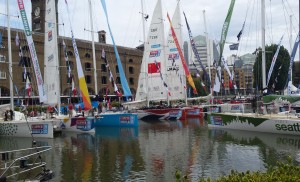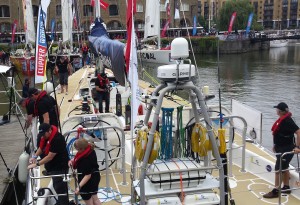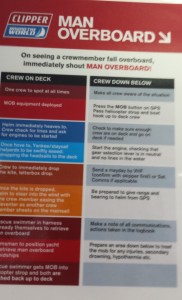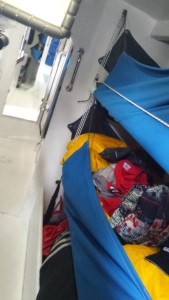 It was naming day on the Clipper Round the World Yacht Race yesterday and all twelve boats, their crews, family and friends, were at St Katherine’s Dock for the naming ceremonies. I went along as the guest of Sue, the Story Bazaar sailor and blogger ( suepsails ), who will be sending dispatches from the other side of the world as she tackles the roaring forties on the Australian leg of the circumnavigation.
It was naming day on the Clipper Round the World Yacht Race yesterday and all twelve boats, their crews, family and friends, were at St Katherine’s Dock for the naming ceremonies. I went along as the guest of Sue, the Story Bazaar sailor and blogger ( suepsails ), who will be sending dispatches from the other side of the world as she tackles the roaring forties on the Australian leg of the circumnavigation.
There was a decided buzz about the dockside as people prepared to leave their land lives behind for up to eleven months and go down to the sea in ships. I met some of Sue’s fellow crew members, including Hayley, a dedicated sailor who has been working seven days a week, at two or three jobs, in order to fund a trip which will take her over 40,000 nautical miles across 6 oceans. Hayley and Sue will be aboard ‘Garmin’, one of the seventy five foot yachts taking part in the fourteen, consecutive, races that constitute the global challenge. I was fortunate to go aboard myself being, very inelegantly, hauled up the side by Sue ( who showed excellent upper body strength – necessary for handling the heavy sails ).
seventy five foot yachts taking part in the fourteen, consecutive, races that constitute the global challenge. I was fortunate to go aboard myself being, very inelegantly, hauled up the side by Sue ( who showed excellent upper body strength – necessary for handling the heavy sails ).
The deck isn’t flat but sloping. Crew walk upon it without thinking, after all, they are used to it being at a forty-five degree angle or worse, when they are clipped on to the line running the length of the deck on each side of the companion way. Sails are hauled out of their store below  decks through the foredeck hatch, often wet and very heavy, where they are unfolded on deck and hoist aloft. The bowman, at the front of the boat, is responsible for hoisting the foremost sail, leaning backwards or climbing out on the spinnaker pole. This is what race literature describes as ‘the high adrenaline, all action’ role. I am learning a whole new language and it’s not just the technical terms. Down the ladder into the living and eating area one sees instructions, posted on both sides of the galley, about what to do if someone falls over board
decks through the foredeck hatch, often wet and very heavy, where they are unfolded on deck and hoist aloft. The bowman, at the front of the boat, is responsible for hoisting the foremost sail, leaning backwards or climbing out on the spinnaker pole. This is what race literature describes as ‘the high adrenaline, all action’ role. I am learning a whole new language and it’s not just the technical terms. Down the ladder into the living and eating area one sees instructions, posted on both sides of the galley, about what to do if someone falls over board
Each 23m long boat carries up to 24 people at any one time, rotating, twelve on and twelve off duty, to keep the boat sailing for 24 hours a day. At 5.65m at its widest ( about eighteen feet ) there is not a lot of room below. Each crew member has a bunk ( shared with one other ) and a cubby hole or two for belongings. There are four sets of three bunks atop each other ( see photo ). The galley is ingenious, with a cooker on gimbals and some seating space. The two lavatories, or ‘heads’ – a term which goes back to the seventeenth century if not further – are pristine, but won’t stay that way. At each stopover a ‘deep clean’ is undertaken by the crew about to take the boat on to the next leg. I found the living quarters tiny and being tall meant constant stooping. Yet folk will live here for up to thirty-five days at a stretch. On the Pacific Ocean leg, the nearest people to the crew will, at one point, be those on the International Space Station.
gimbals and some seating space. The two lavatories, or ‘heads’ – a term which goes back to the seventeenth century if not further – are pristine, but won’t stay that way. At each stopover a ‘deep clean’ is undertaken by the crew about to take the boat on to the next leg. I found the living quarters tiny and being tall meant constant stooping. Yet folk will live here for up to thirty-five days at a stretch. On the Pacific Ocean leg, the nearest people to the crew will, at one point, be those on the International Space Station.
The navigation area is small, well-lit and high-tech, with radar, GPS, satellite and the control panel for electricity on the boat ( each has its own generator ). The ship’s log is completed on computer.  More familiar was the chart already laid out for the start of the first leg, plotting the boat’s course out of the Thames and down the Channel past Dover. The forecast is fine and the moon will, doubtless, lie on the straits. The boats set off on Sunday. I have nothing but admiration for people, all of whom, saving the skippers, are amateur and 40% of whom had never sailed before venturing on this challenge. Very good luck to them.
More familiar was the chart already laid out for the start of the first leg, plotting the boat’s course out of the Thames and down the Channel past Dover. The forecast is fine and the moon will, doubtless, lie on the straits. The boats set off on Sunday. I have nothing but admiration for people, all of whom, saving the skippers, are amateur and 40% of whom had never sailed before venturing on this challenge. Very good luck to them.
If you enjoyed reading this post you might also like Trust A Nautical Adventure


 RSS – Posts
RSS – Posts